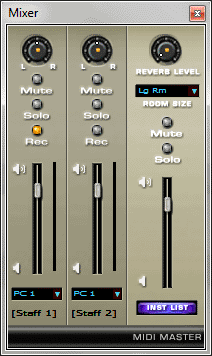Mixer

How to get there
From the Window Menu, choose Mixer.
What it does
The Mixer contains two parts, a master
set of controls and a set of controls for each staff in the score. The
master controls can be used to adjust the volume and reverb of the overall
output much like the master controls on a conventional mixer. The set
of controls for each staff can be used to adjust the volume and pan value
relative to other staves in the score much like the volume sliders and
panning wheels for tracks on a conventional mixer. All settings defined
in the mixer are post-processed and applied over the top of MIDI data
that already exists in the score score including MIDI tool data, Human
Playback data and/or expressions and articulations defined for playback.
In other words the mixer doesn’t change the contour of the playback, only
the overall output or the staff relationship.
Settings applied to staves in the Mixer
are dynamically linked to the ScoreManager. For example, an increase to the volume for one staff changes
the volume setting in the ScoreManager uniformly.
The same is true for the other settings.
- [Pan
dial]. Use this dial to control the pan value for each channel.
Click and drag this dial clockwise to pan the channel right or counterclockwise
to pan the channel left. Playback volume will be weighted to the left
or right speaker accordingly.
- M
(Mute). Click this button to indicate you want the channel to be
silent when you play the score.
- S
(Solo). When you click in the Solo button, you instruct SongWriter
to mute all other staves. In other words, you’ve just isolated a staff
so that only it will play back, and all the other staves are silent. (You
could achieve the same effect by clicking in the Mute button for all other
staves).
You can solo more than one staff, if you wish—for
example, you can solo two or three staves, and all the others will be
silent. In fact, you can solo all staves, although there wouldn’t be much
point, since you may as well solo none of them.
- R
(Record). Use these buttons to specify which staves wyou would
like to record into with HyperScribe.
If Record
into One Staff or Split into Two Staves is selected in the Record Mode
submenu of the HyperScribe Menu, you don’t need to use the Mixer to specify
which staff to record into; simply click the staff in the score that you
want to record into. If, however, you prefer to use the Playback Control’s
Record button (instead of clicking a measure in the score), then you must
use the Mixer’s (or ScoreManager’s) R parameter to indicate the staves
in which you would like to record. (Note you can use the ScoreManager
to specify individual layers for recording. See ScoreManager).
If you would like to record into two or more
staves simultaneously, first, from the HyperScribe Menu, choose Record
Mode, and then Multitrack Record. Then click the R button for all staves
you would like to record into. The buttons turn yellow, indicating that
SongWriter will record into those staves. Click the Record button in the Playback
Controls to begin recording. (Also, when you click the HyperScribe tool,
the HyperScribe frame appears on the selected staves.)
- [Volume
Slider]. Use this slider to adjust the volume for this staff (and
all other staves set to the same channel). Note you can enter a specific
volume value for each channel in the ScoreManager.
- PC
[Program Change]. This popup menu lists the playback sounds in the selected device (the General MIDI instrument or included SmartMusic SoftSynth GM sound library). You can click the popup arrow and choose from the complete list of General MIDI sounds. Click the popup arrow and choose Edit Patch to open the Set Patch To dialog box where you can assign Program data for playback through an external MIDI device. See To
establish MIDI sound settings for a score Instrument. If a device uses midnam files, the Sound popup menu will display banks and sounds for the device associated with the midnam file. To use midnam files, see Configuring a new device in Audio MIDI Setup. If SmartMusic SoftSynth is selected, to select percussion, choose "MakeMusic GM : Bank 128."
- Instrument.
This is the name of the instrument assigned to the staff (as shown in
the ScoreManager).
- Reverb
Level. The reverb dial controls the overall amount of decay, or
length of time a sound persists after released. This dial applies to the
overall output. Click and drag this dial clockwise to increase the reverb
effect, or counterclockwise to decrease the reverb effect.
- Room
Size. This setting has the effect of simulating a room size to
make your music sound as though it is being performed in a small room,
concert hall, or anything in between. Click and drag the dial clockwise
to increase the ‘size’ of the room.
- Master
Mute. Click this button to mute all staves. When you do so, the Mute button is also activated in the staff Mixer controls.
- Master
Solo. Click this button to solo all staves. When you do so, the
Solo button is also activated in the staff Mixer controls.
- Master
Volume. Click and drag this slider up to increase the volume of
the overall output, or down to decrease the overall volume.
- Instrument
List. Click this button to open the ScoreManager where you can
define new instruments, and make additional volume and pan settings for
individual layers and chords. See ScoreManager.
See Also:
Playback
ScoreManager


